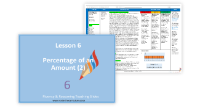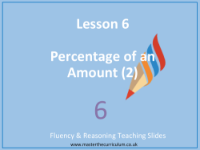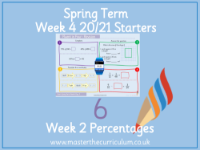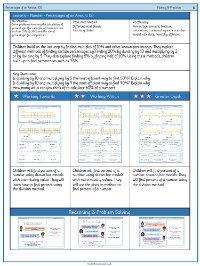Percentages - Percentage of an amount (range of percent) - Planning

Maths Resource Description
In the Year 6 spring term, students dive into the concept of percentages, specifically learning how to find a percentage of an amount with a range of percentages. The lesson is supported by resources such as worksheets and a presentation, with key vocabulary including 'percentage', 'amount', 'fraction', and 'calculation', among others. The session begins with a starter activity that prompts students to complete 'fluent in four' questions, setting the stage for the day's learning objective. The lesson builds on previous knowledge by teaching students how to find multiples of 10% and other known percentages. One of the activities involves using a bar model to calculate 40% of 90, where students first determine 10% by dividing the total amount by 10 and then multiply that by 4 to find 40%. This method is practiced with various calculations, and students discuss and correct any misconceptions about the process or the interpretation of the bar model.
Further activities challenge students to consider fractions of percentages, such as finding 5% as half of 10%, and explore different methods to calculate this, including division by 10 followed by division by 2, or by understanding 5% as 1/20 of the whole. Students are encouraged to apply these methods to different amounts, including metric measurements. The lesson then progresses to more complex percentages, like 65% of 30m, where students are taught to break down the problem by first finding 10%, halving it for 5%, and then combining these to reach the final answer. Group work and independent activities with differentiated worksheets allow students to practice fluency and reasoning. Key questions stimulate critical thinking about the efficiency of different methods for finding percentages, while common misconceptions are addressed to ensure a comprehensive understanding of the concept. The lesson concludes with a reflective 'Give me five' activity, where students assess their learning, the skills they've used, and what they found challenging, ensuring they remember the key points from the lesson.



